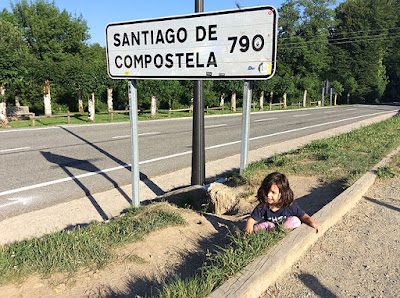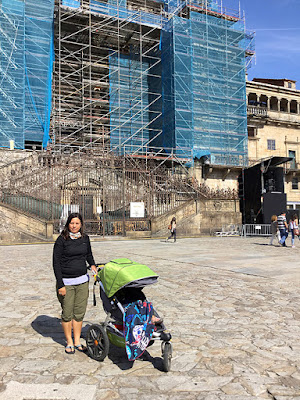Ana and I got the bright, perhaps ludicrous idea to embark on the Camino de Santiago after learning about it from our friend Ryan who had previously walked the journey. What solidified the idea was another mutual friend of ours, Kate, mentioned she was planning to walk the Camino in summer of 2017. In a not so subtle way Ana and I sort of interjected ourselves into her plans, “Wouldn’t it be great if we get the band back together…” With that said, Kate put a bug in Monica’s ear who was destined to couch surf the summer away anyhow.
Kate, Monica, Ryan, Ana, and I were part of the same cohort of newly arrived teachers to Addis Ababa, Ethiopia in the summer of 2013. Fate put us in the same apartment complex, Varnero, on the outskirts of the city and a far cry from the school; it was where the mud meets the sky. By mud I mean, from July to November in Addis Ababa that year it was unseasonably rainy and sticky…and with our collective shipments and cars wrapped in bureaucratic red tape stuck somewhere in customs, the days ticked slowly away. But the five of us alongside our fellow inmates: Claire Bear, no foot on the break pedal Jerry, Nutella Nella, Tricky Vicki, Downtown Jackie Brown, Eva Keneva, and Sarugula created our own fun at Varnero.
Kate, Monica, Ryan, Ana, and I were part of the same cohort of newly arrived teachers to Addis Ababa, Ethiopia in the summer of 2013. Fate put us in the same apartment complex, Varnero, on the outskirts of the city and a far cry from the school; it was where the mud meets the sky. By mud I mean, from July to November in Addis Ababa that year it was unseasonably rainy and sticky…and with our collective shipments and cars wrapped in bureaucratic red tape stuck somewhere in customs, the days ticked slowly away. But the five of us alongside our fellow inmates: Claire Bear, no foot on the break pedal Jerry, Nutella Nella, Tricky Vicki, Downtown Jackie Brown, Eva Keneva, and Sarugula created our own fun at Varnero.
It was decided that Ana, Ximena, and I would meet Kate
and Monica in Roncesvalles to walk the Camino Francés-the Saint James Way. We spent nearly a year doing our research and procuring the necessary items-day
packs, shoes, underwear, a stroller…those sort of things. The idea was go light. Below are photos and useful information we learned along the way that might be of use to future pilgrims, especially those wishing to travel with a toddler.
This post will be the mother of posts for us. We've included selected photographs snapped along the way coupled with thoughts and reflections. Enjoy.
This post will be the mother of posts for us. We've included selected photographs snapped along the way coupled with thoughts and reflections. Enjoy.
| (Photo: Sculpture at the Roncesvalles Albergue) Roncesvalles sits on the descent of the Pyrenees and is part of the Basque region. |
| Day 2: Zubiri to Pamplona. (Photo: Stretching on the Camino) Stretching is important, though we didn't always follow our advice. The heat wave was still hanging around and would for several more days. We became obsessed with checking the weather forecast and charting what the temperatures would be a week ahead. We also discovered we had over packed and needed to unload some items. There's a great service offered by Ivar who runs the Camino forum where you can go to the post office (Correos) and stuff all your extra items into one of the three sizes of flat rate boxes and ship it to Ivar who will store it for up to 60 days. We did this...twice. We noticed a lot of pilgrims over-packed. Personally, I had two shirts, two pairs of underwear, two pairs of shorts, two pairs of socks, toothbrush, razor, charger, Ipod, guidebook, sleep sack, pillow case, duct tape, needle and thread, lighter, a water bottle, and Ximena's clothes. It was pretty light. If you are taking a child on a stroller, get a jogger type. We decided on a Burley because it looked and felt more durable plus the storage space below for food, diapers, and tire repair kit (you will get many flats). We weren't disappointed in our stroller choice, it worked like a champ and kept Ximena safe, dry and warm. |
| (Photo: View from our room in Puente La Reina) The key to eating a good meal is to ask the volunteer at the albergue where the locals eats. And if that doesn't work, follow the Spaniards. |
| Day 4: Puente la Reina to Estella. (Photo: Future wine) |
| (Photo: Day 5: On the way to Los Arcos) It was the first not-so-hot-day of the Camino. We traveled through farms and trees a good part of the day. |
| (Photo: approaching the lavender fields of Villamayor de Monjardin) |
 |
| (Photo: Los Arcos) |
 |
| (Photo: Albergue La Fuente in Los Arcos) The type of albergue on the Camino can enhance the overall experience. La Fuente has character. It is owned by a couple of Austrians who have walked the Camino several times so they know what is important to a pilgrim. |
 |
| (Photo: Taking a swing break) Sometimes you have to. |
| (Photo: Villamayor del Rio) Boasting a population of 50 residents, there were some lovely looking houses. |
| (Photo: Villamayor del Rio) |
| (Photo: Belorado) There was a lot of graffiti and vandalized building on the edge of the town, but there were just an many colorful ones. |
 |
| (Photo: Belorado) It wasn't uncommon site to see giant nests on churches. |
 |
| (Photo: Playground in Agés) Agés was fab, we enjoyed nice meals and our albergue was tops. Again, it was a small village of about 60 people, perfect for a night's rest. |
| Day 13 Hornillos to Castrojeriz. (Photo: A morning in the Meseta) |
| (Photo: The ruins of San Anton) |
| Day 14: Castrojeriz to Frómista. (Photo: looking back towards Castrojeriz) An early start with a climb up Alto de Mostelares. |
| (Photo: Crossing the plateau of Alto de Mostelares and gauging the drop to the other side) |
| (Photo: View from Puente de Itero) |
| (Photo: On the path to Frómista) |
| (Photo: Frómista Canal de Castilla) |
| (Photo: Carrión de los Condes-watch for the crossing sheep!) Seriously. |
| (Photo: Sahagún-San Tirso) |
| (Photo: Abandon building in Bercianos del Real Camino) Our albergue Hostel of pilgrims Santa Clara was pretty amazing. We stayed in the "matrimony" room. The owners were very kind, friendly, and helpful. The walls and the decor had character-the hostel is a labor of love. |
| (Photo: Stairs to the bells in Bercianos del Real Camino) |
| (Photo: Yours truly puttering along) Another day of walking along a mostly abandon local road (thanks to the new highway). |
| (Photo: Our 10 year anniversary photo with a pilgrim statue in Mansilla de las Mulas) |
| (Photo: Rio Esla) |
| (Photo: Another pilgrim statue in Mansilla de las Mulas) |
| (Photo: Ximena's new haircut) Ana asked me to go have Ximena's hair trimmed and this is how she returned. I guess we had different ideas about "a trim." In the end it suited her well, but I'm biased. |
| (Photo: Ximena testing the waters) Albergue Vieira was another one of our favorites. The owner Amelia and staff really took care of us. Although it sits alongside the main road, it channels a relaxing vibe. The food is excellent and much of the vegetables they serve come from their on-site garden. Also to note is the massage therapist who visits in the evenings. She was the female version of Richard Simmons; upbeat, funny, and athletic. She made me squeal like a baby and wrapped up Ana's leg in red clay and told Ana that she needed to take a rest day or her ankle would continue to swell. |
 |
| (Photo: Papi and Ximena time) |
| (Photo: La Casa de los Dioses) An oasis of goodness. Fill up on nuts, fruits, drinks, cookies, for a donation. Nothing makes you feel better than seeing someone's labor of love devoted to helping others out. To meet the owner David go here. |
| (Photo: Astorga) Ana had many cool stories and encounters prior to our arrival. |
 |
| Day 22: Astorga to Rabanal del Camino. (Photo: Rainbow ahead) It was gentle and easy walk considering I was coughing up and sneezing ever couple of minutes. |
| (Photo: Doing the daily ritual of laundry) Rabanal del Camino was a welcoming town with decent food. It had a laid back chill and somewhat of a pagan vibe about it. |
| (Photo: Castillo de los Templarios in Ponferrada) |
| (Photo: Lunch) When we reached Biduedo we were treated to a heart attack on a plate. Our hotel was the only game in town. |
| (Photo: Caballos in the fog) |
| (Photo: Long and thick black slugs outside of Triacastela) |
| (Photo: 100 KM marker to Santiago) Let the countdown begin. Keep in mind that in a car this would take under an hour, but for us it will be four days of walking. |
| (Photo: Pool in Portomarín) |
| (Photo: Cathedral in Portomarín) |
 |
| Day 29: Portomarín to Palas de Rei. (Photo: Somewhere) Mostly pleasant surrounding. The smell of damp eucalyptus trees was powerful. |
| (Photo: More trees) |
| (Photo: A humble home) This reminds of Charlie Bucket home (from Charlie and the Chocolate Factory). A humble home wedged between two buildings. |

















